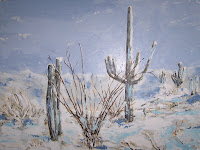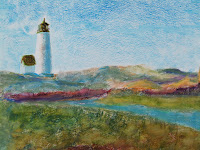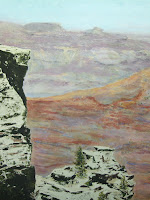
Today’s Image
Golden Bridge
Pastel on canvas panel
10 x 8in/26 x 21cm
2008
In the Studio
Rather than rush into my next project, even if I knew what it was going to be, I decided to work on a quick piece using pastels and a canvas panel that I had painted over with gesso some time back. I’ve heard the best way to be ‘green’ is to re-use what you already have, so I feel good about that.
I haven’t worked with pastels since last fall, but it was fun to use the medium again. Before I started painting with acrylics last year, I first tried pastels. For this piece, I used my old beat-up set of Mungyo Soft Pastel(s) for Artists. These are mini-pastels; that is, each stick is only 1 in/2.5 cm long.
I just happened to see a photo of the Golden Gate Bridge in San Francisco on the back of a travel guide and decided to draw that. I had previously applied the gesso on the canvas panel rather thickly, and I like the texture it gives to the piece, which is 10 x 8 in/26 x 21 cm. It’s Today’s Image.
August in Review
Although I usually review a book or some similar art literature on Friday, this being the last blog in the month, I give a brief review of the month’s blogs in case you missed any or, as I always say, to relive the memory.
In the Art Library will return next Friday. In addition to installments of In the Studio with every blog, here goes:
- How to Draw Anything – August 1 was a Friday, so In the Art Library reviewed a book about how to draw anything (wow)-- a good book for beginner’s with tips on getting started and a lot of encouragement
- So What Is Oil Pastel? – This began a series on using oil pastels when I discovered my old (really old) box of oil pastels and wondered what they were for
- Oil Pastel Learning (Curve) – I experimented with oil pastels and questioned their validity as a real medium
- The 'Secret' of Oil Pastel – after learning a thing or two, I discovered the “secret”
- Painting With Oil Pastels – With my apologies to the Oil Pastel Society, I endorsed oil pastels and told why you must use odorless mineral spirits
- A Book About Art in Santa Fe and Taos – Another Friday and reviewed this great book with a history of painters in Santa Fe and Taos along with their beautiful paintings
- 4 Steps to Renew Your Interest in Art (Make Your Art a Priority – Step 1) – This began a two-week series of blogs on renewing your interest in art beginning with suggestions on how to find time for your art
- Renew Your Interest in Art - Step 2 (Invest in a Few Art Supplies) – With only seven different items, you can start to draw with very good results
- Explore Art - Step 3 (Explore Your Local Art Venues) – Some reminders on where you to find art in your community but may have forgotten
- Explore Art Galleries & Art Festivals – A discussion of how art galleries work and the fun you can have by exploring the many kinds of art festivals
- Learn to Paint and Draw - Friday again, so I reviewed another ‘learning- how’ book, but this one gives specifics on the subjects you’re drawing rather than just how to draw
- Explore Art Supply Stores – Shopping for art supplies can be fun
Explore Art Online – This blog gives just a few examples of what’s out there online on the millions of art websites - Art Educate Yourself (Step 4) – The last blog on renewing your interest in art suggests places and ways to enhance your knowledge
- Varnishing Acrylics - A blog about varnishing acrylics with a varnish that I found that works well
- A Visionary Impressionist – In the Art Library reviewed a beautiful coffee-table book on the work of Manet; it’s worth a look
- What Is Creativity? – This blog began an unexpected series on the subject of creativity
- A Definition of Creativity – I found a definition I like
- What Artists Had to Say – Includes quotes from 10 well-known artists on what inspired them
- Seven Ways to Stimulate Creativity – Orbisplanis’ very own ways to get those creative juices flowing again
So that was Orbisplanis in August 2008 in a nutshell. We’ll do this again at the end of September.
Cheers!


















